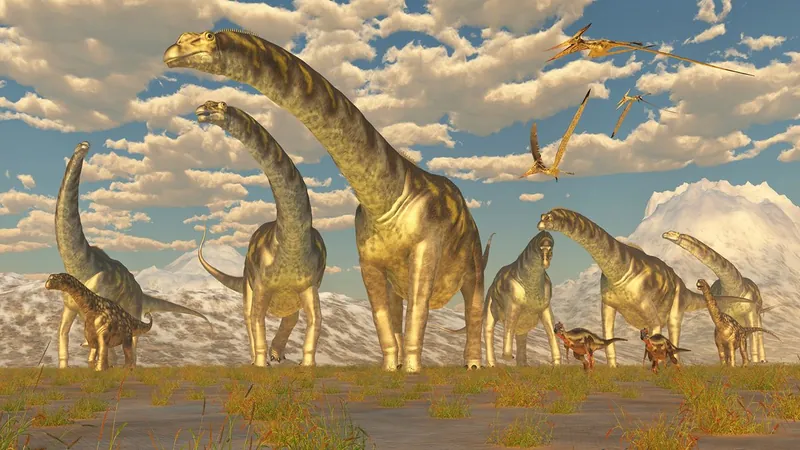
Argentinosaurus: The Colossal Dinosaur That Rivaled a Football Field
2025-01-08
Author: Yu
Introduction
Prepare to be amazed! Argentinosaurus, one of the largest dinosaurs to ever inhabit our planet, was truly a giant among giants, with its length nearly matching that of a football field!
Historical Background
Argentinosaurus roamed the Earth during the Late Cretaceous period, about 94 to 97 million years ago, in what is now the lush landscapes of Patagonia, Argentina. As a member of the sauropod family, these long-necked, plant-eating titans were a testament to nature’s incredible ability to create such massive creatures.
Discovery and Size Estimations
First described by esteemed paleontologists José Bonaparte and Rodolfo Coria in the 1990s, this herbivore was estimated to reach lengths between 95 to 130 feet (30 to 40 meters) and could weigh an astonishing 60 to 100 tons (around 55 to 91 metric tonnes). Imagine looking up at an animal that stretched an impressive 100 feet long—it's no wonder Argentinosaurus captures the imagination!
Structural Adaptations
Structural adaptations were crucial for its survival. The strong vertebrae in its lengthy neck enabled it to browse the treetops for food, while its colossal body helped it store energy and maintain balance. The dinosaur's legs were thick and column-like, perfectly designed to support its enormous weight. And let’s not forget about its formidable tail, which may have served as both a counterbalance and a defensive tool against predators.
Fossil Evidence
Despite the extensive fossil remains found, including dorsal vertebrae and limb bones, paleontologists are limited by the lack of a complete skeleton. Comparisons to related species like Patagotitan help them piece together the full picture of this magnificent creature's anatomy.
Ecosystem and Behavior
As one of the largest among the titanosaur family, Argentinosaurus shared its ecosystem with formidable neighbors, including the fearsome Giganotosaurus. This apex predator posed a serious threat, making social behavior essential for survival. Evidence suggests Argentinosaurus may have lived in herds, providing crucial protection for the young and facilitating the efficient foraging of vegetation.
Diet and Feeding Habits
Imagine witnessing a herd of these massive creatures moving gracefully through verdant landscapes, working together to strip massive amounts of foliage! Their diet primarily consisted of ferns, cycads, and conifer trees. With their peg-like teeth, these gentle giants primarily stripped leaves and swallowed whole, relying on gastroliths—stones that aided in digestion—to break down tough plant fibers.
Late Cretaceous Environment
The environment of Late Cretaceous Patagonia was vastly different from today's dry terrain. It was characterized by warm, humid conditions teeming with lush vegetation, perfect for supporting such enormous herbivores. However, it wasn't just a paradise for plant-eaters; it was also a playground for some of the largest carnivores to ever roam the Earth.
Conclusion
While scientists are still piecing together the complete story of Argentinosaurus, it undeniably stands out as a symbol of the awe-inspiring diversity and majesty of the prehistoric world. Fossil remnants provide only glimpses of its life, but they remind us of an era when these colossal creatures ruled the land, capturing our imagination and reminding us of the intricate balance of ancient ecosystems.
Stay Tuned!
Stay tuned for more jaw-dropping revelations from the world of dinosaurs!

 Brasil (PT)
Brasil (PT)
 Canada (EN)
Canada (EN)
 Chile (ES)
Chile (ES)
 Česko (CS)
Česko (CS)
 대한민국 (KO)
대한민국 (KO)
 España (ES)
España (ES)
 France (FR)
France (FR)
 Hong Kong (EN)
Hong Kong (EN)
 Italia (IT)
Italia (IT)
 日本 (JA)
日本 (JA)
 Magyarország (HU)
Magyarország (HU)
 Norge (NO)
Norge (NO)
 Polska (PL)
Polska (PL)
 Schweiz (DE)
Schweiz (DE)
 Singapore (EN)
Singapore (EN)
 Sverige (SV)
Sverige (SV)
 Suomi (FI)
Suomi (FI)
 Türkiye (TR)
Türkiye (TR)
 الإمارات العربية المتحدة (AR)
الإمارات العربية المتحدة (AR)